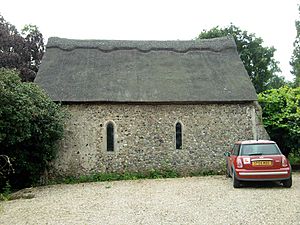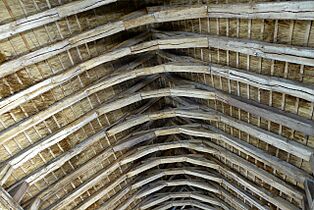St James' Chapel, Lindsey facts for kids
St James' Chapel is a very old building, built in the 1200s (that's the 13th century!). It's near a village called Lindsey in Suffolk, England. Long ago, it was a special kind of church called a chantry chapel. A chantry chapel was a place where people would pray for the souls of others, often important families from a nearby castle. Today, it's a protected historical site, known as a Grade I listed building and a scheduled monument. This means it's super important and kept safe for the future!
Contents
A Chapel's Journey Through Time
We don't know the exact year St James' Chapel was built. Most of it was made in the 1200s, but some older stones were even reused from other buildings! The chapel was used for prayers until 1545. At that time, many chapels like this were "dissolved," meaning they were closed down.
After it closed, the King gave the chapel to a man named Thomas Turner. He decided to turn the chapel into a barn! This happened in the same year, 1545. It's thought that the roof was changed from tiles to thatch (a roof made of straw) when it became a barn.
Early Records of the Chapel
The chapel was named after St James the Apostle. It was built to serve Lindsey Castle, which was very close by. Today, only the old earth mounds of the castle remain.
The first time the chapel was written about was in 1240. A woman named Nesta de Cockfield, who was in charge of Lindsey Castle, gave the churches in Lindsey and Kersey to a place called Kersey Priory. In 1242, she added a special tax on Cockfield to help pay for lights inside the chapel.
Repairs and Changes
The chapel was repaired sometime in the late 1400s or early 1500s. During these repairs, the roof was made lower, and new wooden beams were put in. It's also possible that the chapel was made a bit shorter at this time. St James' continued to be a chapel until it was closed in 1545.
What the Chapel Looks Like
The chapel was built using brick, stone, and flint. It is about 8.8 meters (29 feet) long and 4.87 meters (16 feet) wide. The height from the floor to the roof is about 3.3 meters (11 feet).
Windows and Doors
On the south wall, you can still see the original pointed windows, called lancet windows. There's also an old stone arched doorway. On the north wall, two original windows were filled in with bricks and covered up. Another original window on this wall was changed into a doorway.
The east wall has a window with three sections. The west wall has a window that was bricked up and a brick doorway. Inside the chapel, there's a special shallow basin from the late 1200s called a piscina. It has a pretty arch shape with three leaf-like parts.
Gallery






